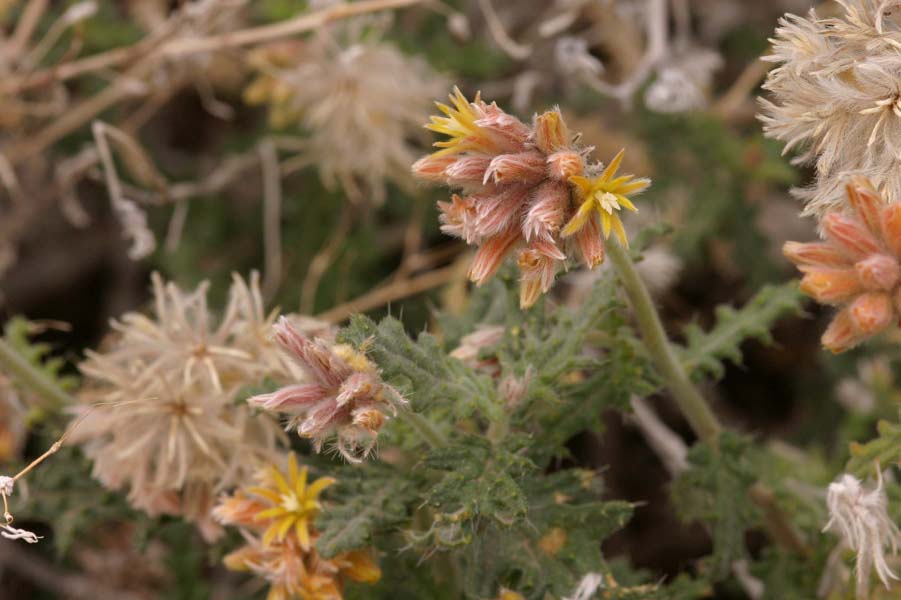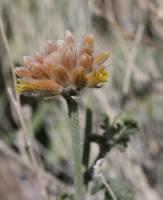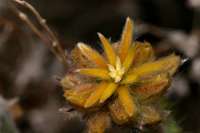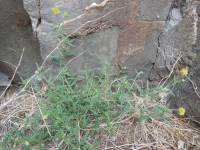|
|
|
|
Family: Loasaceae
stinging serpent
|
Plant: perennial shrub; to 1 m tall; hairs include barbed, stinging and dendritic forms Leaves: short-petiolate, 2-7.5 cm long, elliptic; lower surface densely covered with dendritic trichomes; margins sinuate-toothed to pinnately lobed; upper leaves subsessile, lanceolate INFLORESCENCE: strongly congested cymes, 1-4 cm in diameter, appearing white from dense covering of trichomes, these 1-1.5 mm long; peduncles bractless, 2-10 cm long Flowers: ca. 1 cm long at anthesis; subtending bract linear; calyx persistent, the lobes linear, appearing plumose with long trichomes; petals distinct, linear, also plumose, persistent, yellowish; stamens 5, shorter than the petals, opposite the sepals, persistent, distinct and free; connective prolonged much past the anthers, inflated, yellow; pistil 3-carpellate, the style short, the stigma conical, level with lower portions of the anthers Fruit: achenes, ca. 1.5(-2) cm long including the persistent floral parts, the seed-containing portion 3-4 mm long. SEED 1, subapical; testa non-sculptured; endosperm lacking Misc: Scattered along washes, rocky slopes or outcrops, roadsides, often on limestone or gypsum; 700-1600 m (2300-5200 ft); Jun-Oct REFERENCES: Christy, Charlotte M. 1998. Loasaceae. J. Ariz. - Nev. Acad. Sci. 30(2): 96. VPAP (Christy 1998), Correll and Johnston 1970 Duration: Perennial Nativity: Native Lifeform: Subshrub General: Shrubs or suffrutescent perennials, to 1 m tall; stems and leaves covered with barbed, stinging hairs. Leaves: Alternate and sessile or nearly so; blades 2-8 cm long, elliptic to lanceolate with pinnately lobed or sinuate-toothed margins; leaf underside more densely hairy and lighter in color than upper leaf surface. Flowers: White, yellow, and pink, clustered in dense heads 1-4 cm in diameter, the heads on long peduncles, 2-10 cm long; flowers 1 cm long at maturity; petals and sepals similar in appearance, linear, pink and plumose (hairy) on the outside surface, appearing white due to the dense hairs, and yellow on the inside surface. Fruits: Achenes 1.5 cm long, including persistent floral parts. Ecology: Found along washes, on rocky slopes, and roadsides, often in limestone or gypsum soils, from 2,000-5,500 ft (610-1676 m); flowers June-October. Notes: This is a mostly Chihuahuan Desert species. It is distinctive because of being totally covered with stinging hairs (be careful, they really do sting!); the flowers in dense headlike clusters, which when fresh are hairy, pink, and white on the outside and yellow on the inside; spent flowers simply appear white and hairy; and the leaves which have lobed edges. Ethnobotany: Unknown Etymology: Cevallia is named for Don Pedro Cevallos Guerra (1760-1840), the Spanish Minister of State under King Charles IV and Ferdinand VII; sinuata means wavy, referring to the leaf margins. Synonyms: None Editor: SBuckley 2010, AHazelton 2017 |






